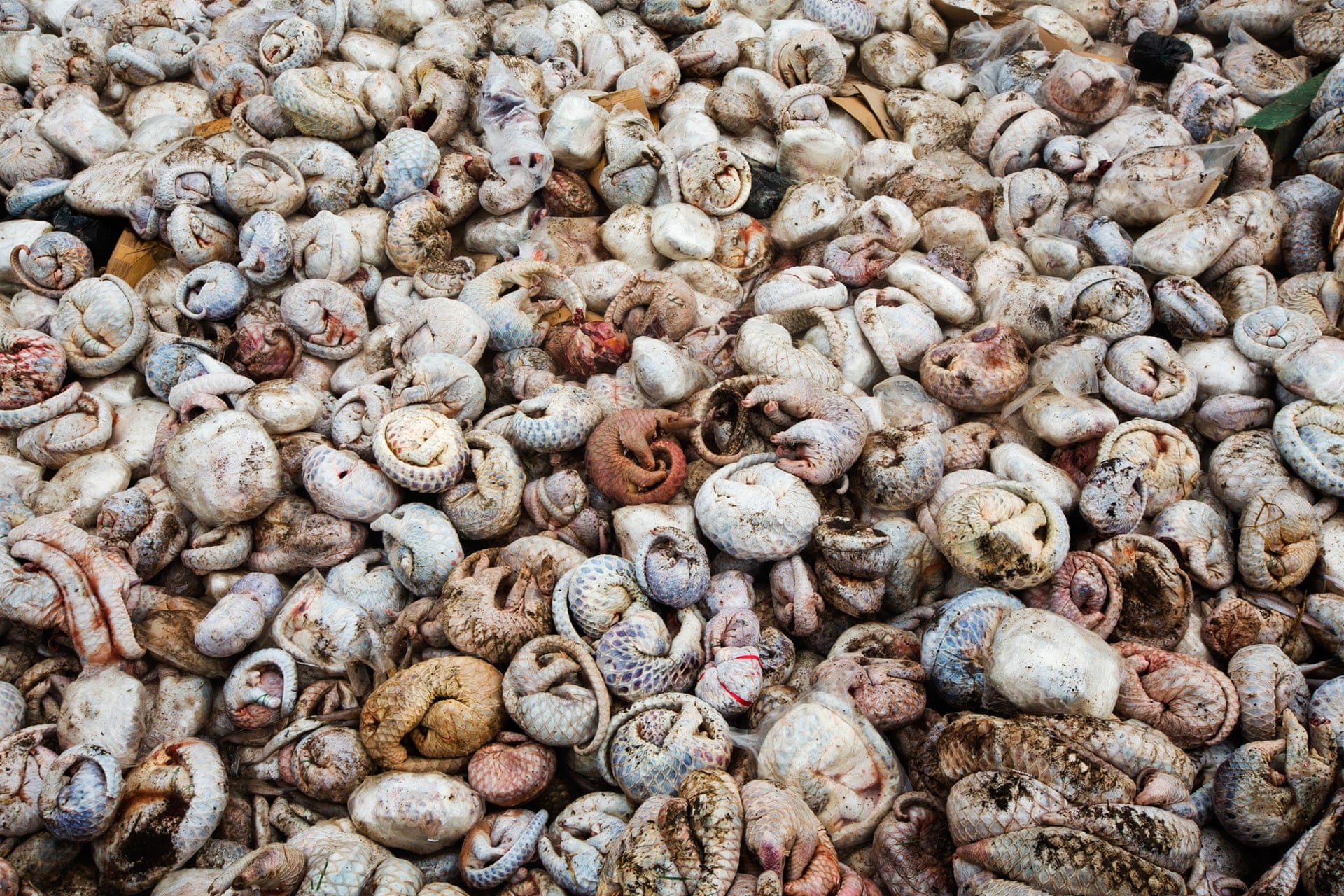
Three to four thousand frozen
pangolins lie in a pit before being burnt in Medan, Indonesia. This
huge seizure was a joint operation between the Indonesian National
Police’s criminal investigation division and the Wildlife Conservation
Society’s wildlife crimes unit, from a warehouse in Medan, the largest
city on the island of Sumatra, on 23 April. A total of 96 live animals
were found including five tonnes of frozen pangolins, 77kg of scales
with an estimated street value of $1.8m (£1.2m), plus 24 bear paws: photo by Paul Hilton/WCS via The Guardian, 30 April 2015
Another armored animal -- scale
....lapping scale with spruce-cone regularity until they
form the uninterrupted central
..tail-row! This near artichoke with head and legs and grit-equipped gizzard,
..the night miniature artist engineer is,
........yes, Leonardo da Vinci's replica --
...........impressive animal and toiler of whom we seldom hear.
........Armor seems extra. But for him,
...........the closing ear-ridge --
.............or bare ear lacking even this small
.............eminence and similarly safe
contracting nose and eye apertures
....impenetrably closable, are not; a true ant-eater,
not cockroach eater, who endures
..exhausting solitary trips through unfamiliar ground at night,
..returning before sunrise, stepping in the moonlight,
........on the moonlight peculiarly, that the outside
...........edges of his hands may bear the weight and save the claws
........for digging. Serpentined about
...........the tree, he draws
.............away from danger unpugnaciously,
.............with no sound but a harmless hiss; keeping
the fragile grace of the Thomas-
....of-Leighton Buzzard Westminster Abbey wrought-iron vine, or
rolls himself into a ball that has
..power to defy all effort to unroll it; strongly intailed, neat
..head for core, on neck not breaking off, with curled-in-feet.
........Nevertheless he has sting-proof scales; and nest
...........of rocks closed with earth from inside, which can thus darken.
........Sun and moon and day and night and man and beast
...........each with a splendor
.............which man in all his vileness cannot
...........set aside; each with an excellence!
"Fearfull yet to be feared," the armored
....ant-eater met by the driver-ant does not turn back, but
engulfs what he can, the flattened sword-
..edged leafpoints on the tail and artichoke set leg- and body-plates
..quivering violently when it retaliates
.......and swarms on him. Compact like the furled fringed frill
.........on the hat-brim of Gargallo's hollow iron head of a
.......matador, he will drop and will
...........then walk away
.............unhurt, although if unintruded on,
.............he cautiously works down the tree, helped
by his tail. The giant-pangolin-
....tail, graceful tool, as a prop or hand or broom or ax, tipped like
an elephant's trunk with special skin,
..is not lost on this ant- and stone-swallowing uninjurable
..artichoke which simpletons thought a living fable
.........whom the stones had nourished, whereas ants had done
...........so. Pangolins are not aggressive animals; between
.........dusk and day they have not unchain-like machine-like
.............form and frictionless creep of a thing
.............made graceful by adversities, con-
versities. To explain grace requires
....a curious hand. If that which is at all were not forever,
why would those who graced the spires
..with animals and gathered there to rest, on cold luxurious
..low stone seats -- a monk and monk and monk -- between the thus
.........ingenious roof supports, have slaved to confuse
...........grace with a kindly manner, time in which to pay a debt,
.........the cure for sins, a graceful use
...........of what are yet
..............approved stone mullions branching out across
..............the perpendiculars? A sailboat
was the first machine. Pangolins, made
....for moving quietly also, are models of exactness,
on four legs; on hind feet plantigrade,
..with certain postures of a man. Beneath sun and moon, man slaving
..to make his life more sweet, leaves half the flowers worth having,
........needing to choose wisely how to use his strength;
...........a paper-maker like the wasp; a tractor of foodstuffs,
........like the ant; spidering a length
...........of web from bluffs
.............above a stream; in fighting, mechanicked
.............like the pangolin; capsizing in
disheartenment. Bedizened or stark
....naked, man, the self, the being we call human, writing-
masters to this world, griffons a dark
.."Like does not like like that is abnoxious"; and writes error with four
..r's. Among animals, one has sense of humor.
.........Humor saves a few steps, it saves years. Unignorant,
...........modest and unemotional, and all emotion,
.........he has everlasting vigor,
...........power to grow,
.............though there are few creatures who can make one
.............breathe faster and make one erecter.
Not afraid of anything is he,
....and then goes cowering forth, tread paced to meet an obstacle
at every step. Consistent with the
..formula -- warm blood, no gills, two pairs of hands and a few hairs -- that
..is a mammal; there he sits on his own habitat,
.......serge-clad, strong-shod. The prey of fear, he, always
...........curtailed, extinguished, thwarted by the dusk, work partly done,
.......says to the alternating blaze,
..........."Again the sun!
.............anew each day; and new and new and new,
.............that comes into and steadies my soul."
Marianne Moore (1887-1972): The Pangolin, from The Pangolin and Other Verse (1936)
MT @TheWCS newsroom: Indonesian Nat'l Police Seize Major #Pangolin Shipment, Arrest Smuggler: image via Nat Moss, 27 April 2015
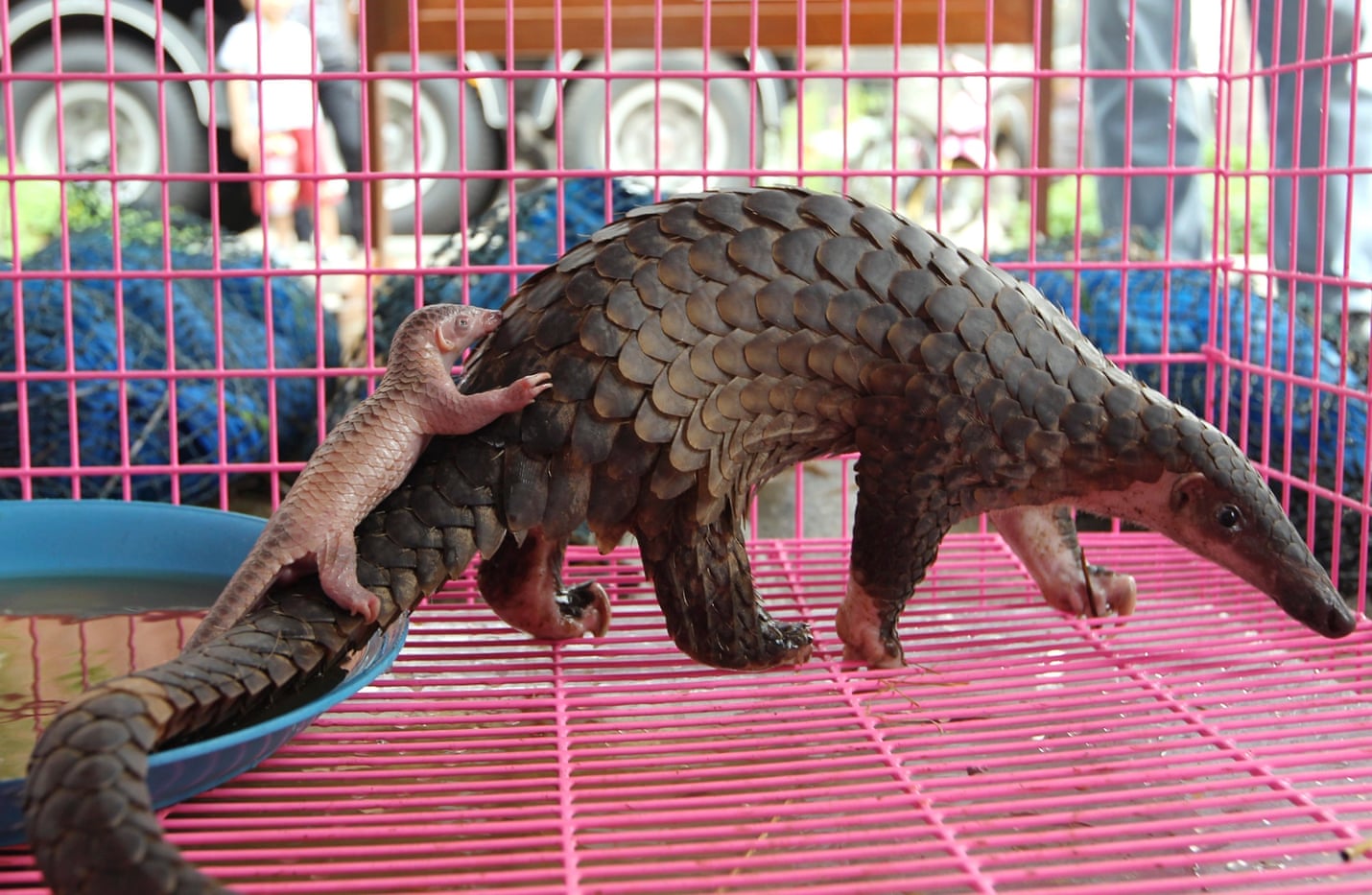
Sunda pangolin (Manis javanica) are among the most trafficked mammals in Asia. Sunda pangolin are critically endangered and IUCN reports that wild populations have halved in the past 15 years. They are in high demand both for their meat and for their scales, which are used in traditional medicine — and as love charms. Tens of thousands of Sunda pangolins have been poached from the wild, headed primarily to China where it is considered a luxury food: photo by Rungroj Yongrit/EPA via the Guardian, 5 February 2015
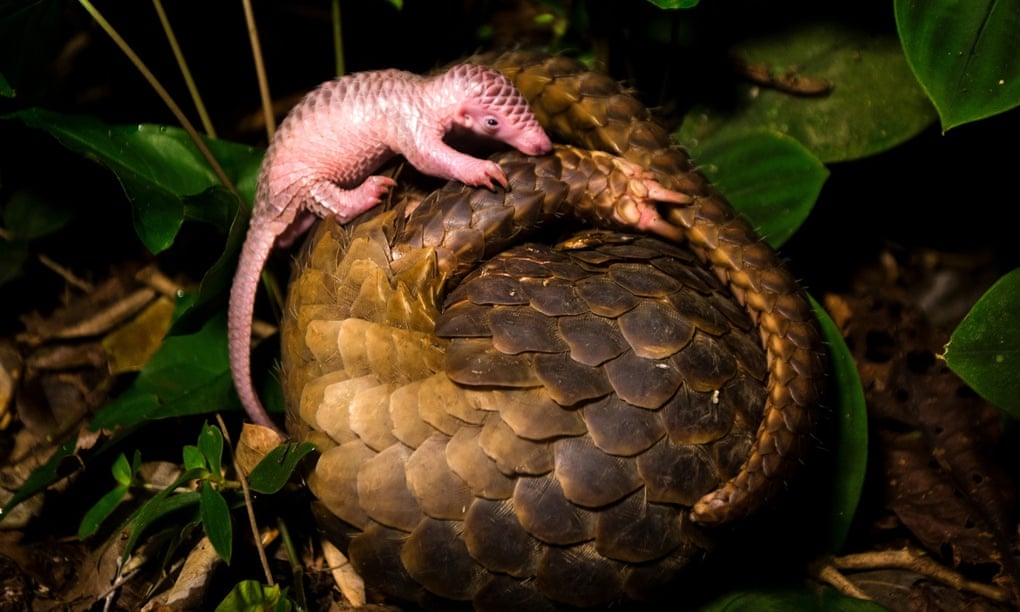
A mother and baby pangolin were part of a release effort on the outskirts of Medan, Indonesia. The mother later died: photo by Paul Hilton via the Guardian, 5 May 2015
94
pangolins released in Sumatra following huge illegal wildlife seizure:
Trafficked pangolins are freed as Indonesian ministers urged harsher
penalties to deter illegal wildlife trade, reports Mongabay: Ayat S. Karokaro for Mongabay, part of the Guardian Environment Network, 5 May 2015
Following a major seizure of illegal wildlife goods in North Sumatra,
the Indonesian authorities released 94 pangolins into the wild last
week, including a newborn whose mother died shortly after the
authorities caught up with the traffickers.
Environment
and Forestry Minister Siti Nurbaya flew to the provincial capital of
Medan to witness the burning of five tons of pangolin meat which had
been confiscated along with 77 kilograms (169 pounds) of pangolin scales
and the live animals.
The minister urged judges to hand down harsher punishments to serve as a deterrent.
“In Palembang (the capital of Jambi province), the prosecutor
demanded the maximum penalty of five years and Rp500 million ($38,000),”
she said. “We expect the same for this network in Medan.”
At present, offenders get an average of eight months behind bars and
Rp10 million. “That’s the reason illegal wildlife networks stay in
business,” said Irma Hermawati, a legal advisor from the nonprofit
Wildlife Conservation Society.
Besides the newborn’s mother, two other pangolins died in the wake of
the raid. A team of veterinarians nevertheless decided that all of the
animals, even the baby, were fit enough to return to the wild.
“If we keep [the baby] first, it’s not necessarily better,” said Tata
Jati Rasa, an official from the provincial Natural Resources
Conservation Agency (BBKSDA). “Let us release it. We believe it can
survive. Let nature determine whether it will live.”
Pangolins are critically endangered and highly sought after in East Asia for use of their body parts in
traditional medicine and cuisine. One of them can sell for
Rp500,000-800,000, according to Didit Wijanardi, a deputy at the
Indonesian National Police’s detectives’ unit (Bareskrim).
“This is the driving factor pushing people into the woods to hunt,”
he said. “We need to fight this because pangolins are a protected
species.”
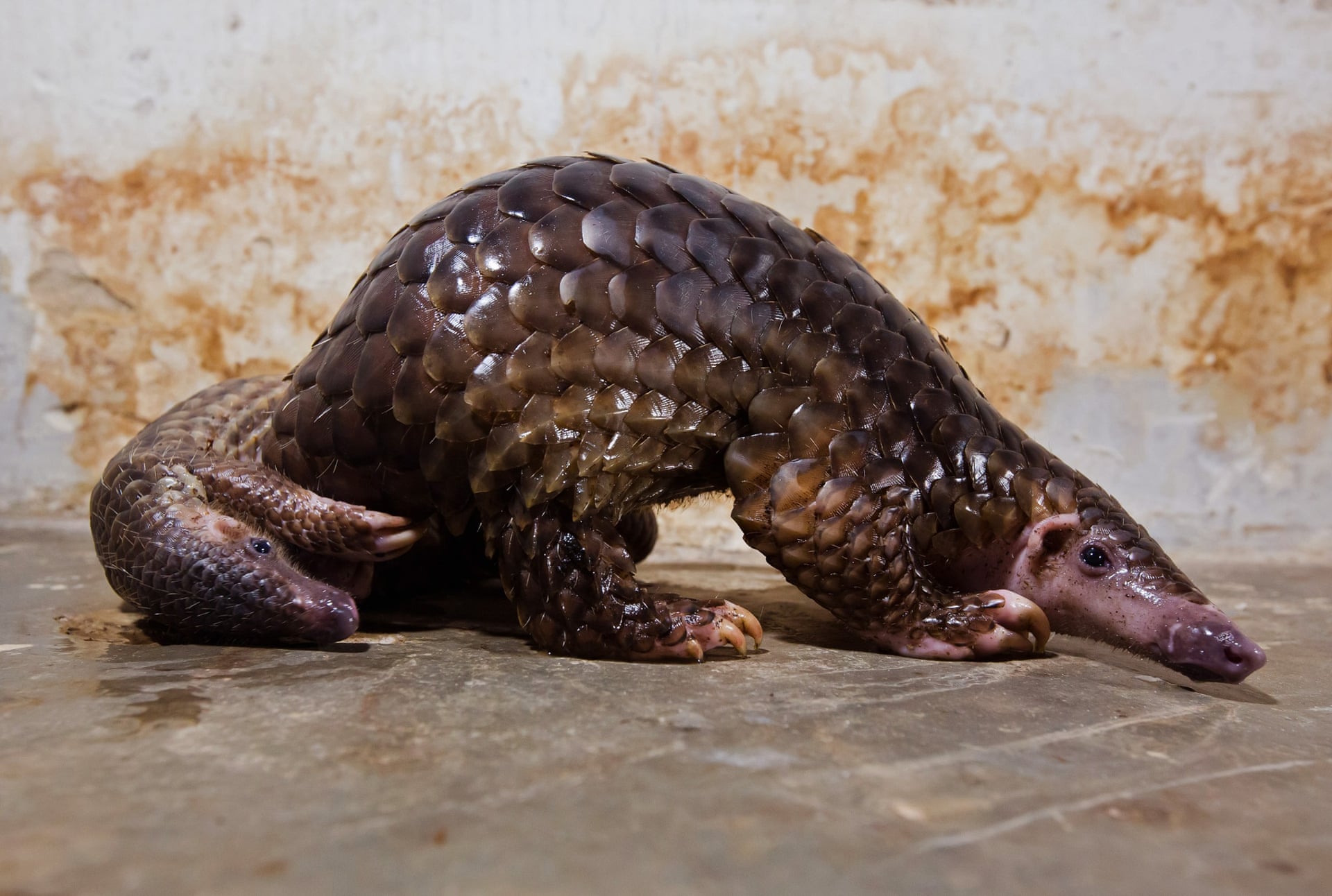
Often known as scaly anteaters, pangolins are the only mammal with scales. Their closest relatives are anteaters, armadillos and sloths. These two will end up on a dinner table in Gunagzhou, southern China, one of the areas of the world where their flesh is considered a delicacy. The illegal trade in pangolins is estimated to be worth about $19bn (£12.7bn) a year: photo by Paul Hilton for WildAid via the Guardian, 16 March 2015

A Sunda Pangolin (Manis javanica), one of two Asian species of pangolin listed as critically endangered on the IUNC red list: photo by Paul Hilton for WildAid via the Guardian, 16 March 2015
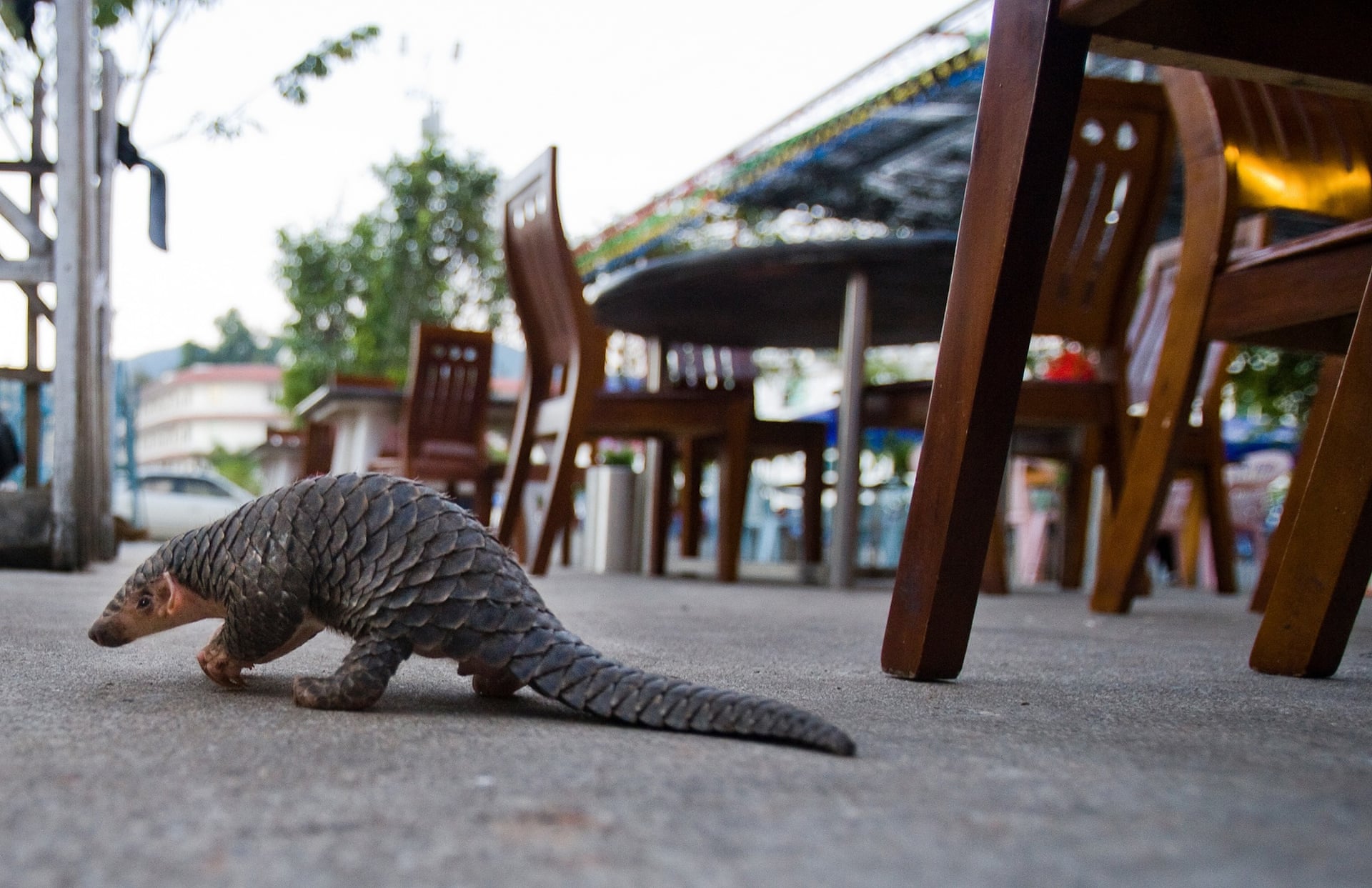
Pangolin are a bit like a friendly, flightless dragons. Many of them have no problem being around people.: photo by Paul Hilton for WildAid via the Guardian, 16 March 2015

An African white-bellied pangolin –- poachers are turning to African pangolins because Asian populations have been denuded: photo by IUCN/ZSL via The Guardian, 28 July 2014
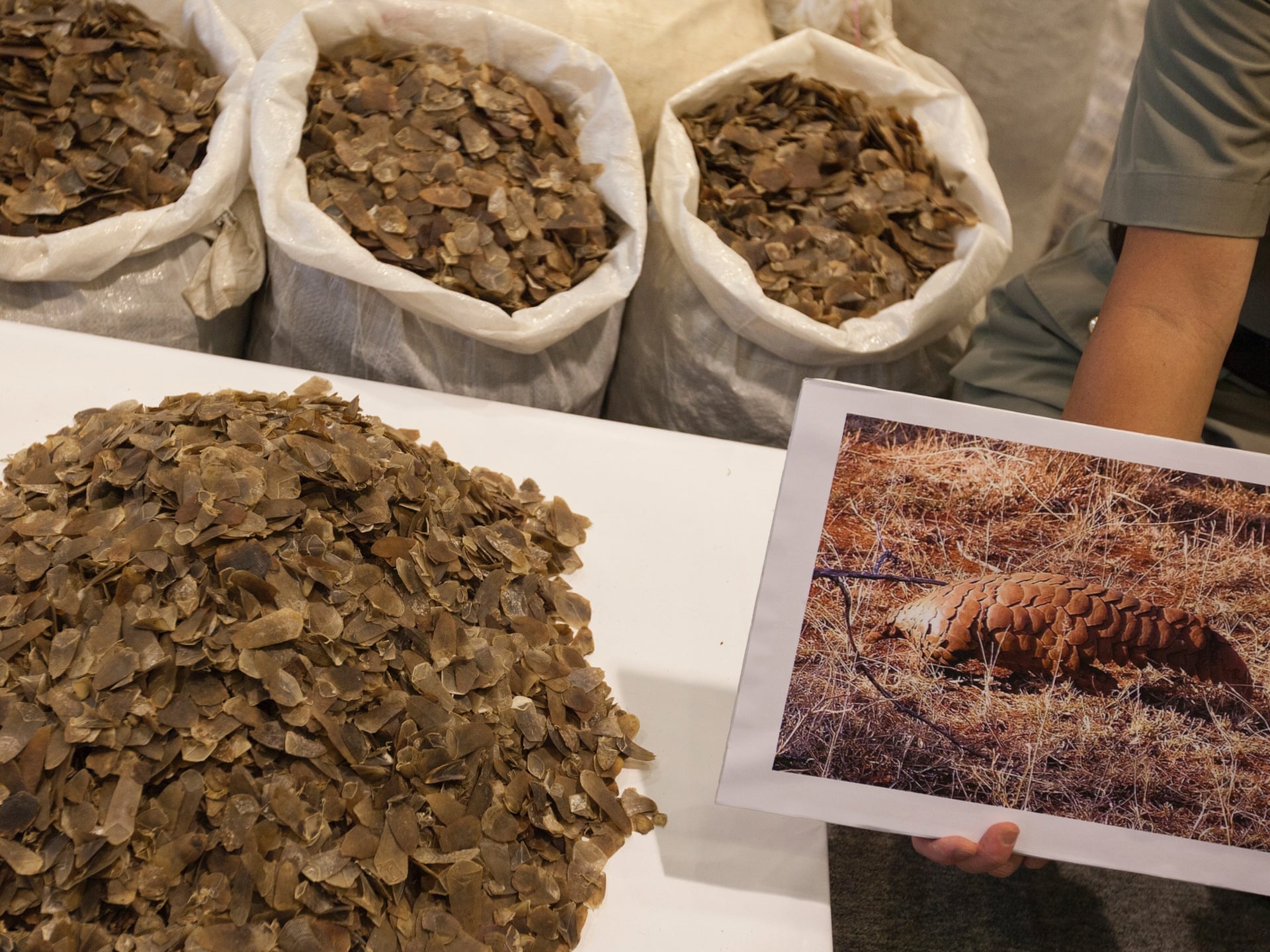
A selection of two tons of pangolin scales, the largest seizure in five years, taken by Hong Kong customs in June 2014: photo by Alex Hofford/EPA via The Guardian, 28 July 2014
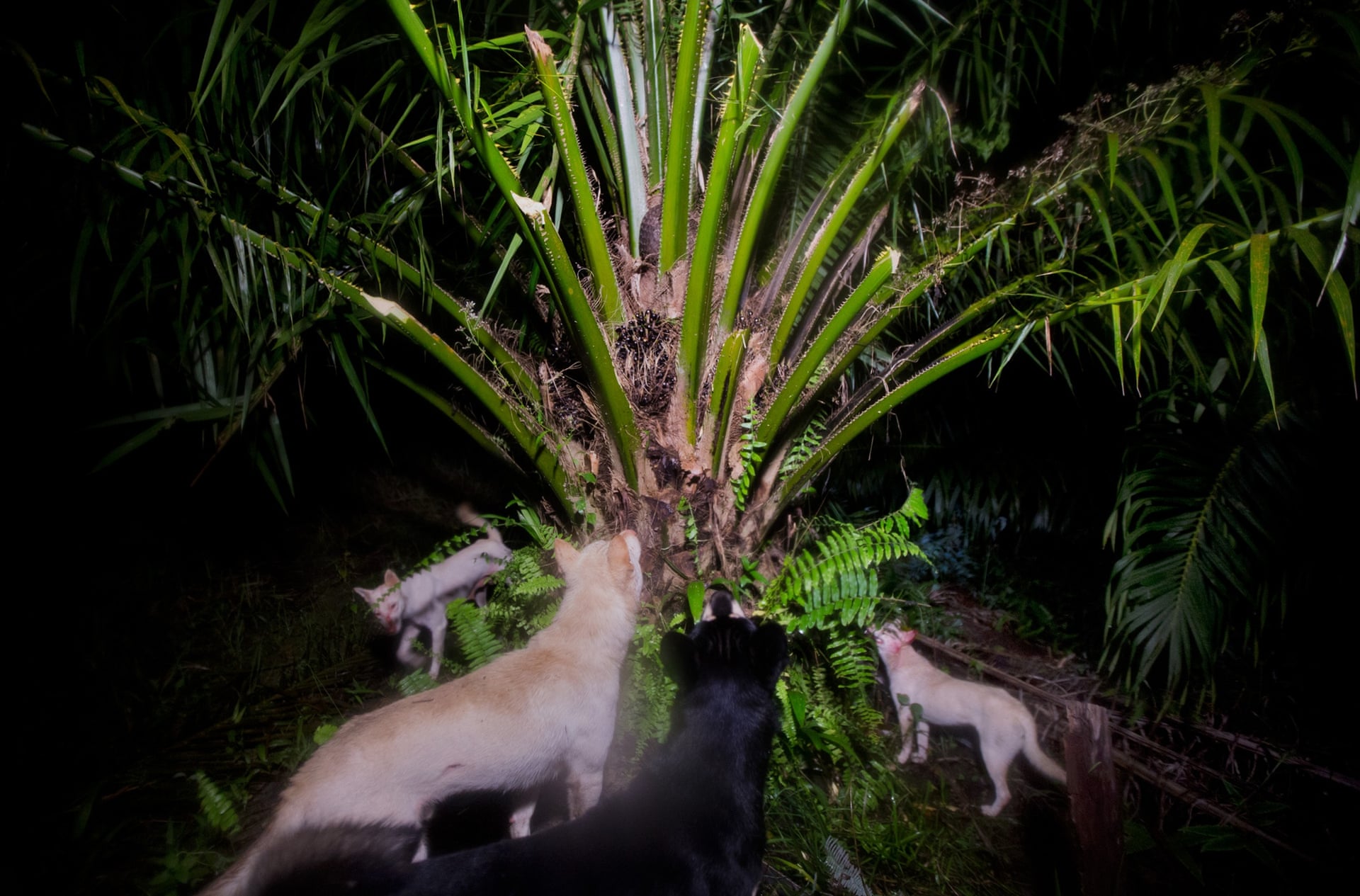
There are four African and four Asian species of pangolin, of the genus Manis in the family Manidae. These
pictures are all taken in Indonesia. This image shows hunting dogs,
used to catch the pangolins, surrounding a tree in Kalimantan where one
is trying to hide.: photo by Paul Hilton for
WildAid via the Guardian 10 March 2015

A critically endangered pangolin curls up into a ball to resemble a giant pine cone as a poacher nears the tree where it is trying to hide: photo by Paul Hilton for WildAid via the Guardian 10 March 2015
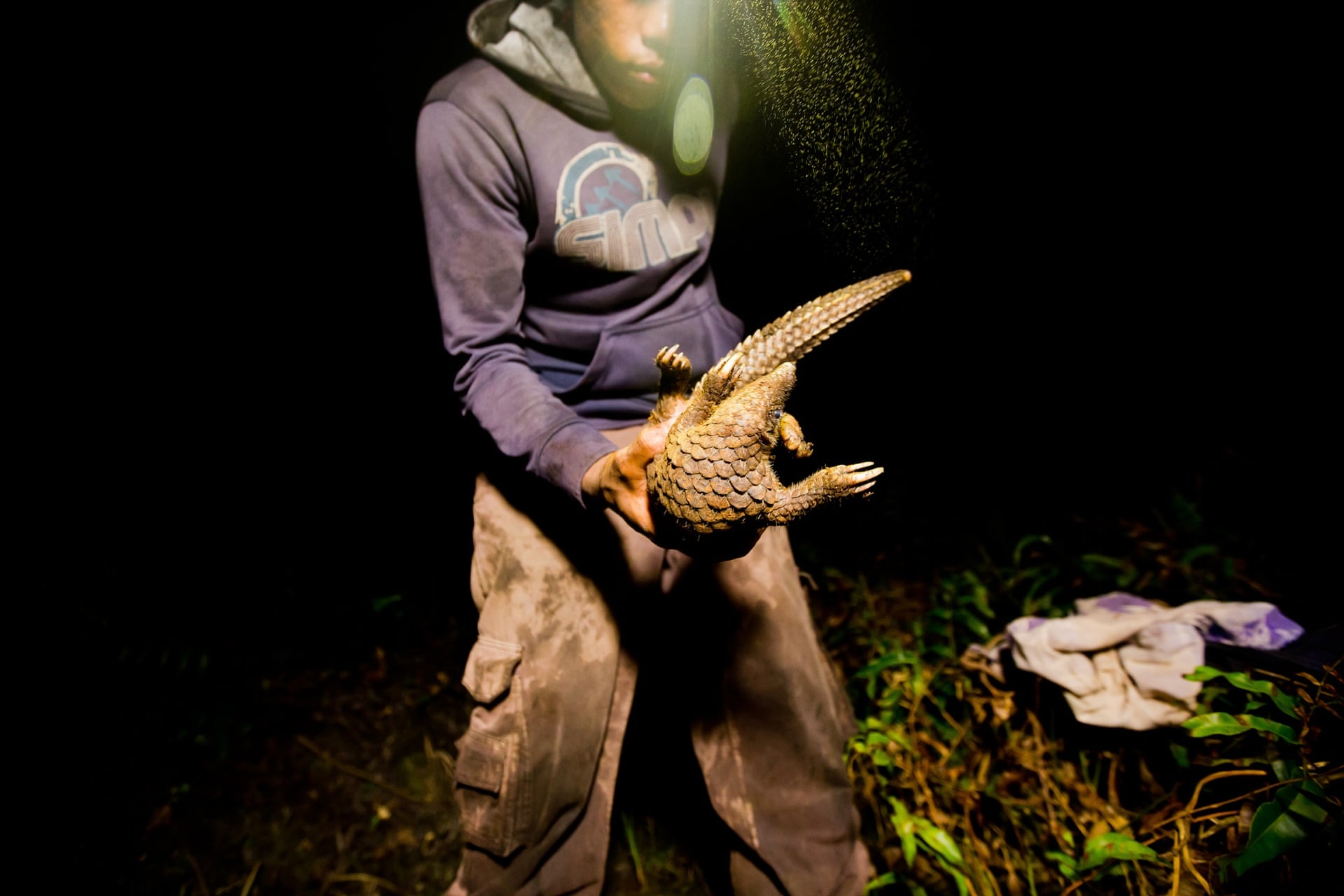
A poacher catches a juvenile sunda pangolin in Indonesia: photo by Paul Hilton for WildAid via the Guardian 10 March 2015
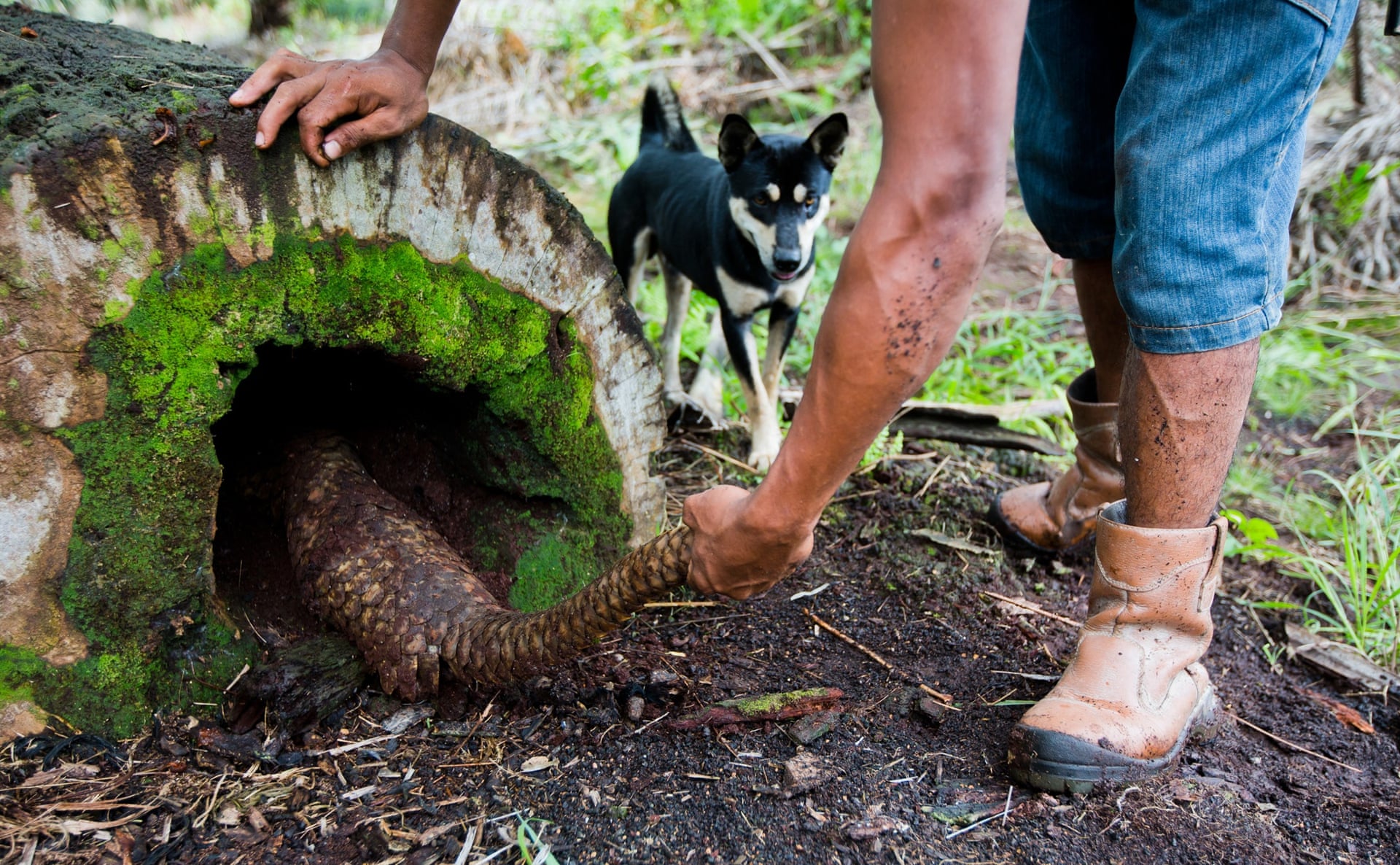
Poachers across
Indonesia sell critically endangered live pangolins to middlemen for $28
(£18.70) to $31 per kilo; the average size of a pangolin is six to
seven kg.: photo by Paul Hilton for WildAid via the Guardian 10 March 2015
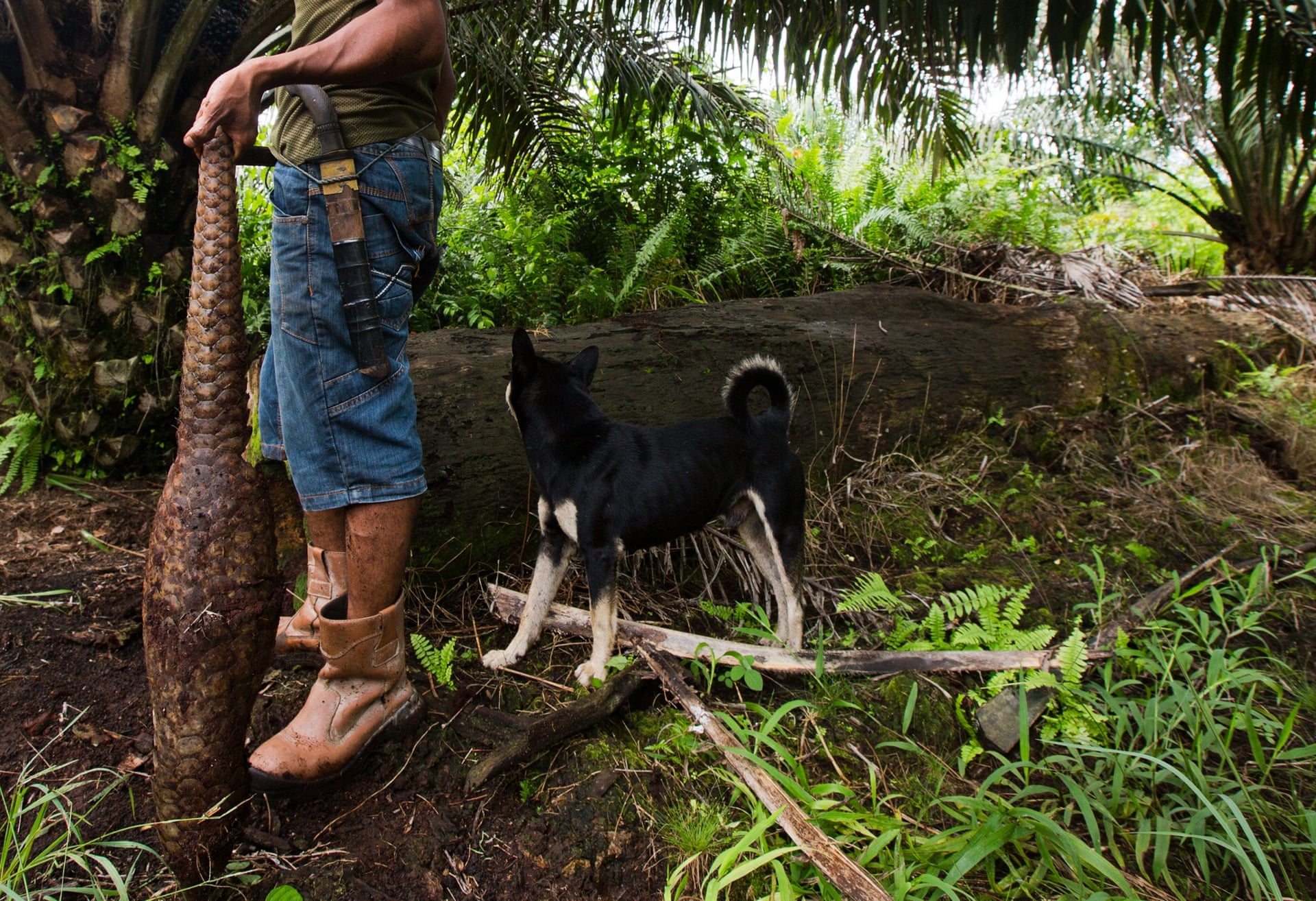
Researchers at the
International Union for the Conservation of Nature (IUCN) say that over a
million pangolins were caught in the last decade, which makes them the
most illegally traded mammal in the world.: photo by Paul Hilton for WildAid via the Guardian 10 March 2015
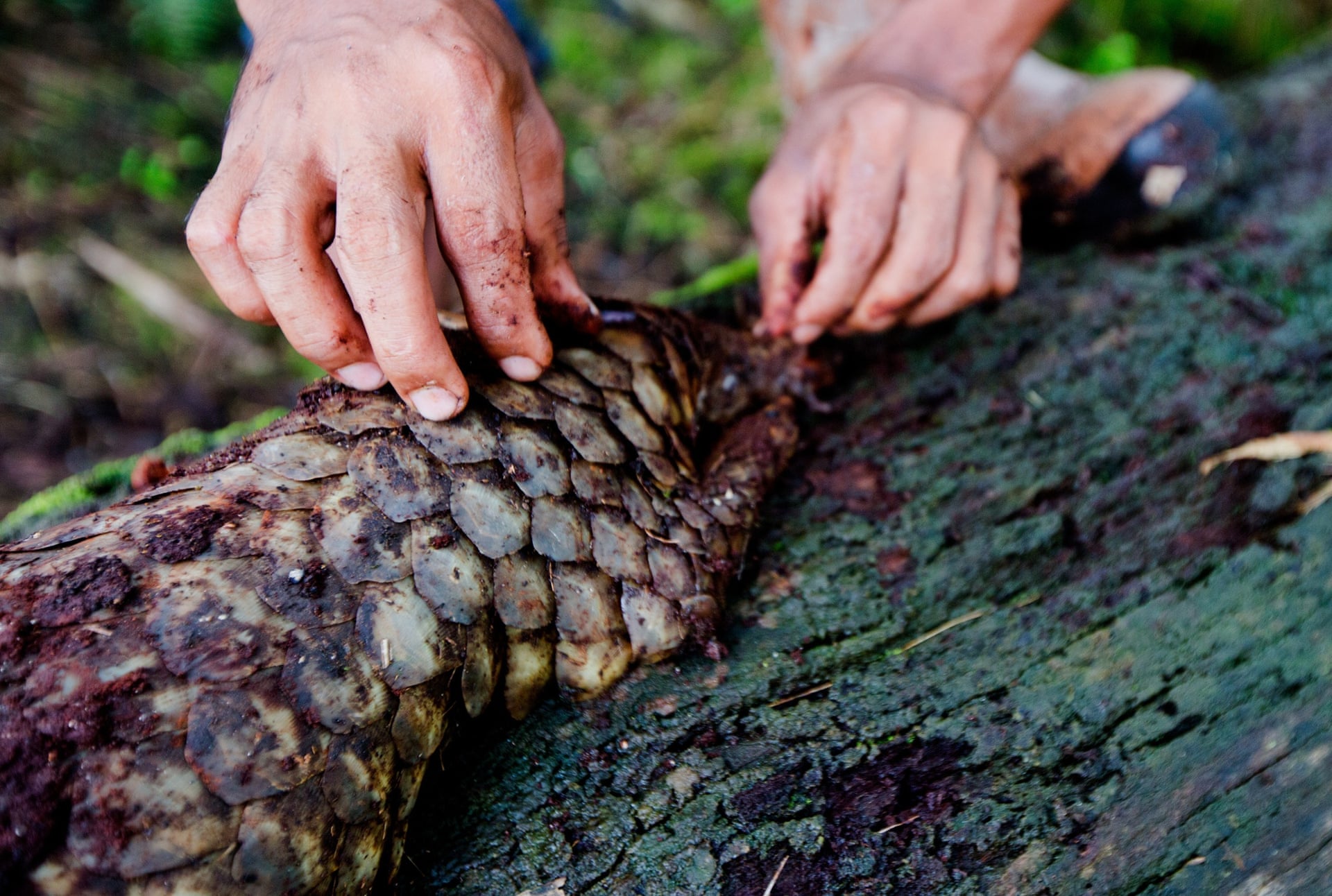
The demand for
pangolin meat, which is considered a delicacy, and scales, which are
used in traditional medicine, particularly in China and Vietnam, is
pushing the pangolin to extinction.: photo by Paul Hilton for WildAid via the Guardian 10 March 2015
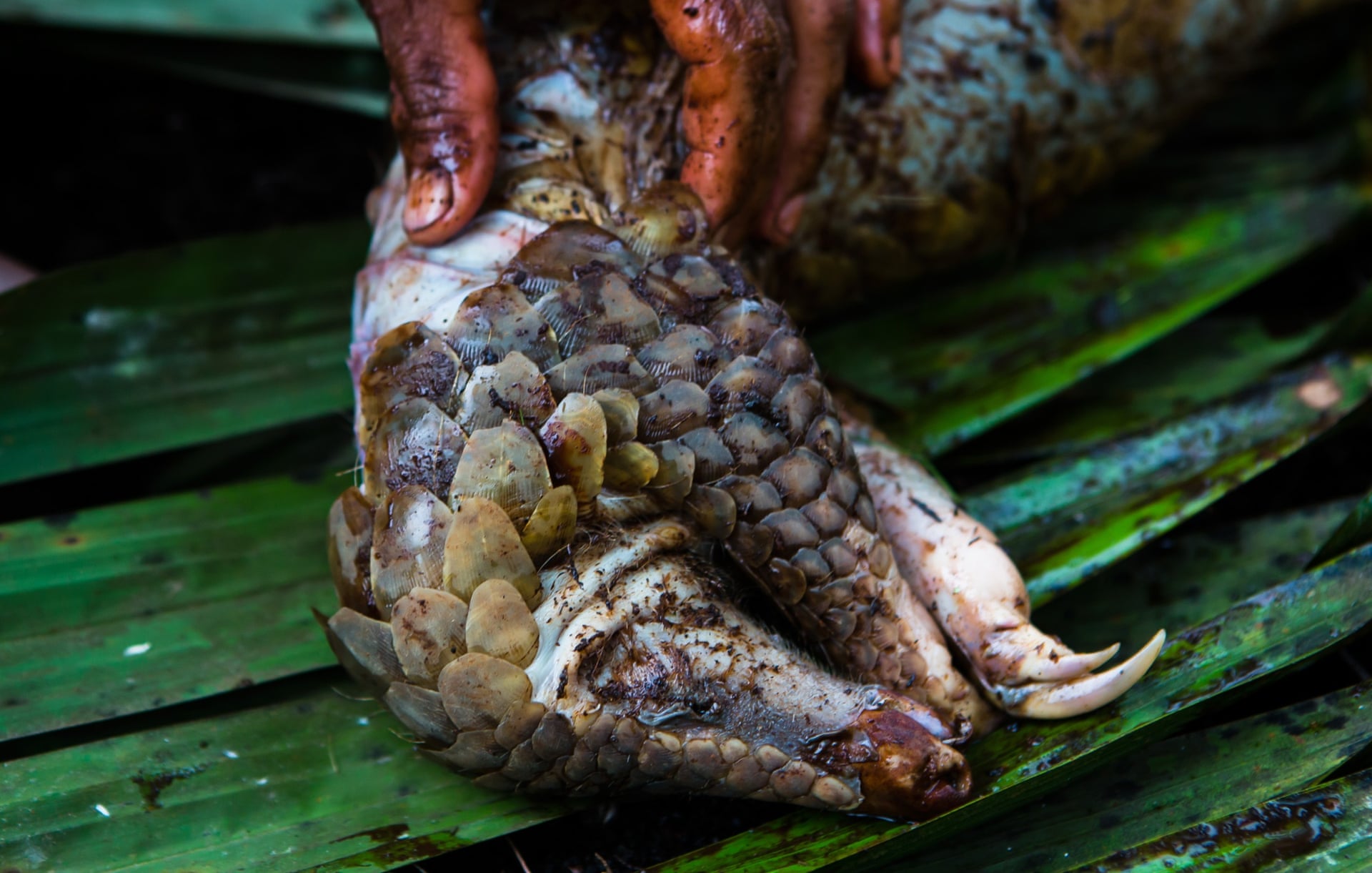
A pangolin releases a foul smell when scared, like a skunk –- though it is not enough to ward off a pack of poacher’s dogs: photo by Paul Hilton for WildAid via the Guardian 10 March 2015
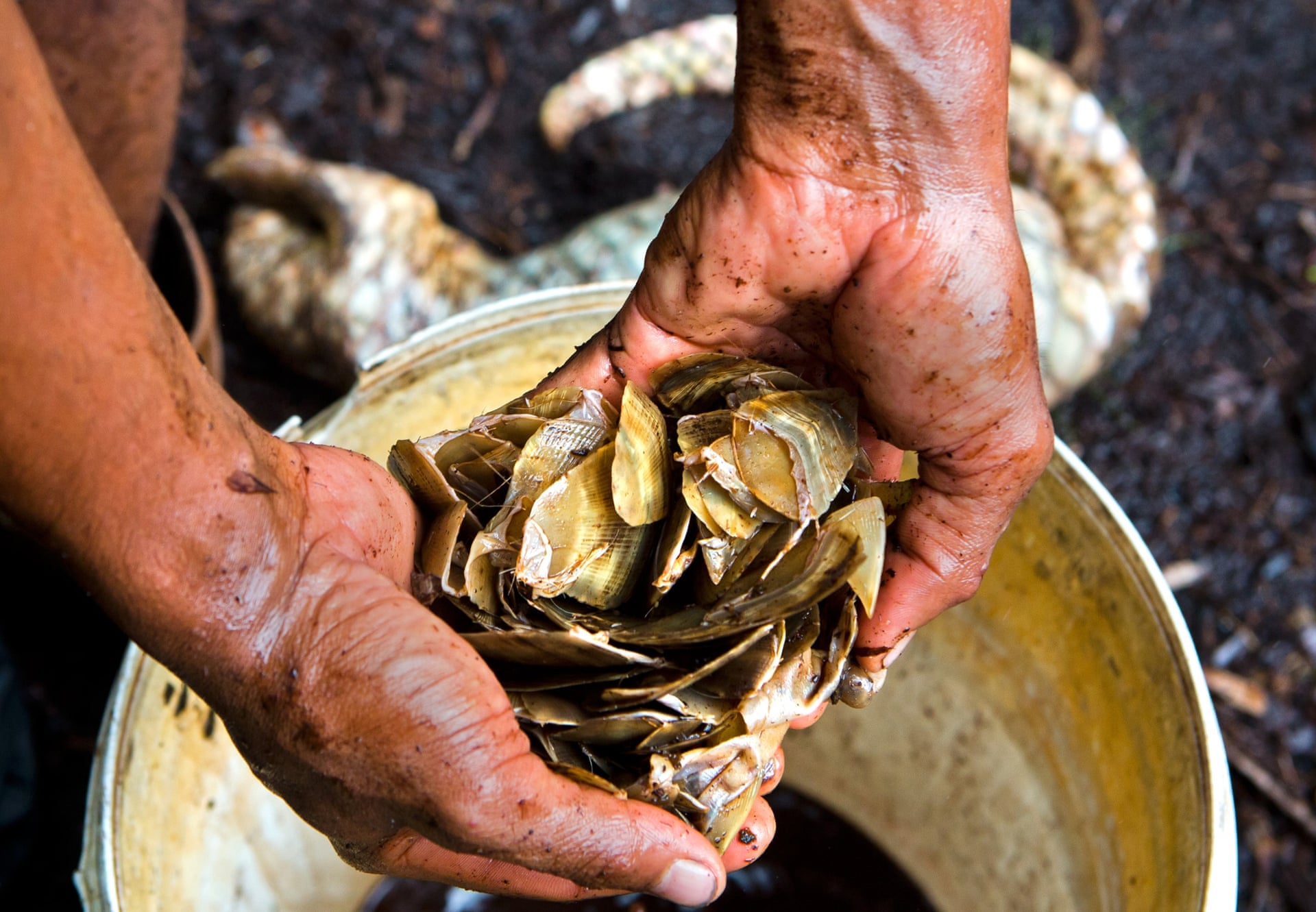
Already this year 125kg of pangolin scales were intercepted by the
Indonesian authorities en route to Hong Kong: photo by Paul Hilton for
WildAid via the Guardian, 10 March 2015
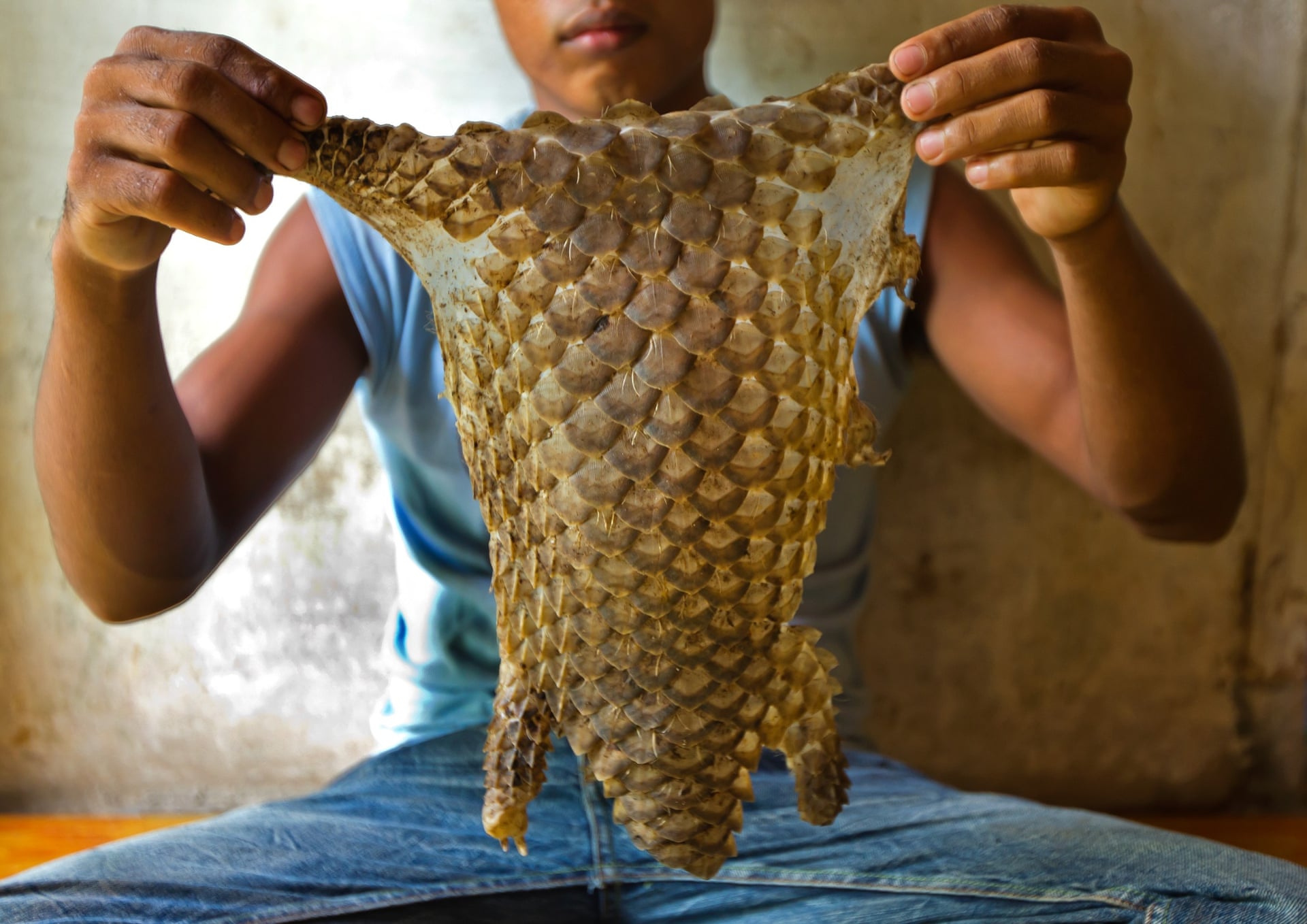
A poacher holds up the skin of a pangolin with the scales still attached: photo by Paul Hilton for WildAid via the Guardian 10 March 2015
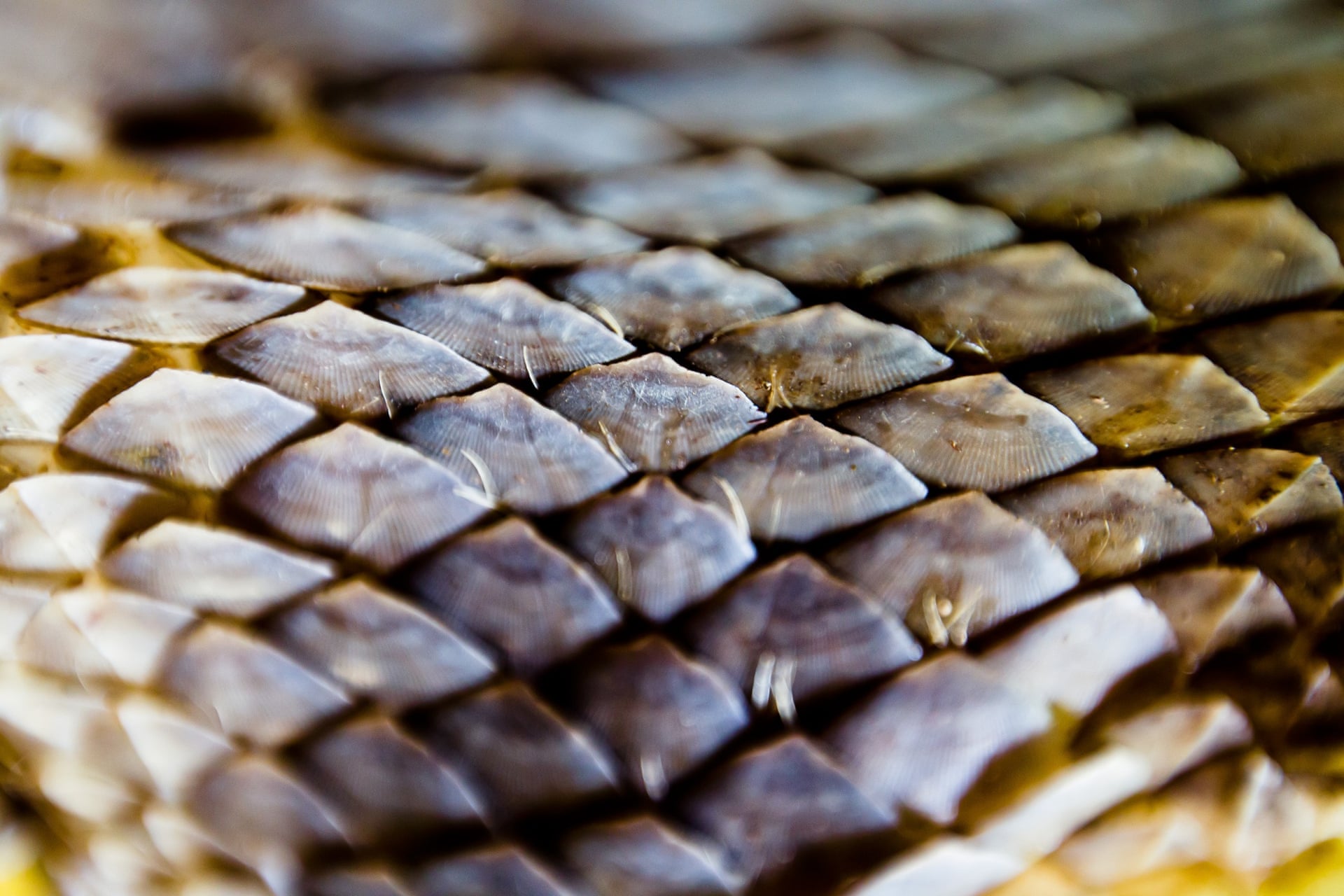
Detail of a pangolin’s skin. Their scales are made of keratin, which is also found in human hair and nails.: photo by Paul Hilton for WildAid via the Guardian 10 March 2015
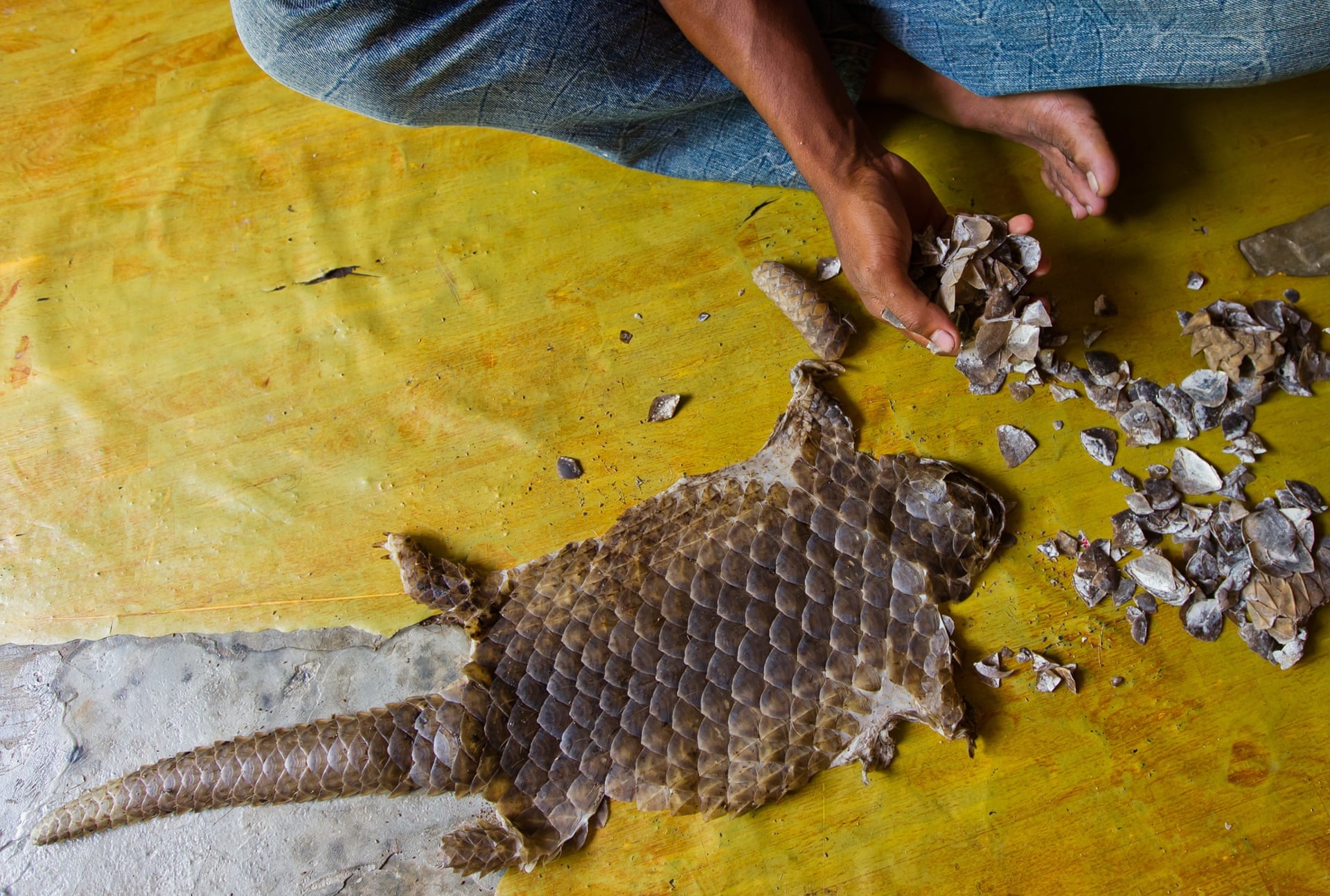
A pangolin skin and, on the right, some scales: photo by Paul Hilton for WildAid via the Guardian 10 March 2015
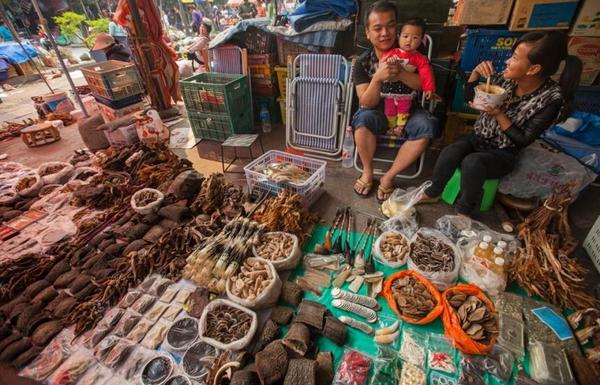
The
tip of the iceberg #illegal #wildlifetrade on #Burma #China
#wildlife #ecocide: image via Peter Burton @peterburton @peteswildlife,
21 July 21 2015
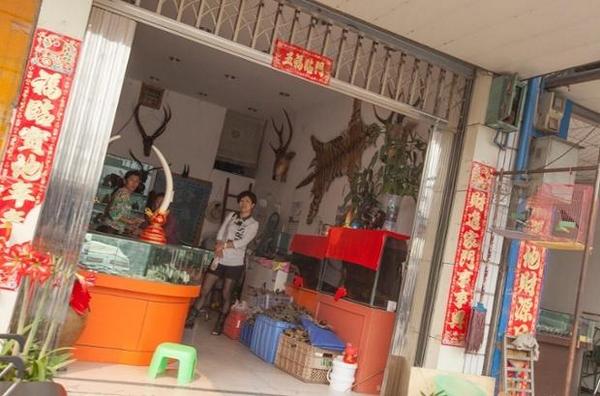
The tip of the iceberg #illegal #wildlifetrade on #Burma #China #wildlife #ecocide: image via Peter Burton @peterburton @peteswildlife, 21 July 21 2015
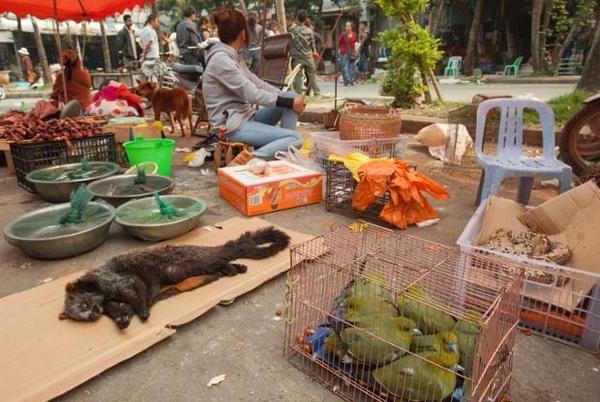
The tip of the iceberg #illegal #wildlifetrade on #Burma #China #wildlife #ecocide: image via Peter Burton @peterburton @peteswildlife, 21 July 21 2015
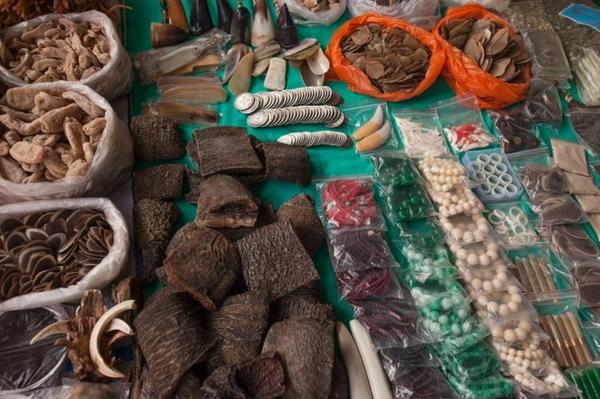
The tip of the iceberg #illegal #wildlifetrade on #Burma #China #wildlife #ecocide: image via Peter Burton @peterburton @peteswildlife, 21 July 21 2015
In 2014, 6.7 tons of African #pangolin scales were
confiscated in Asia. In 2013, it was just over 600KG @THTZim: image via
United for Wildlife @united4wildlife, 23 April 2015
Pangolin scales for sale on Daluo market Illegal #wildlifetrade #Burma: image via calfune @calfune, 26 July 2015
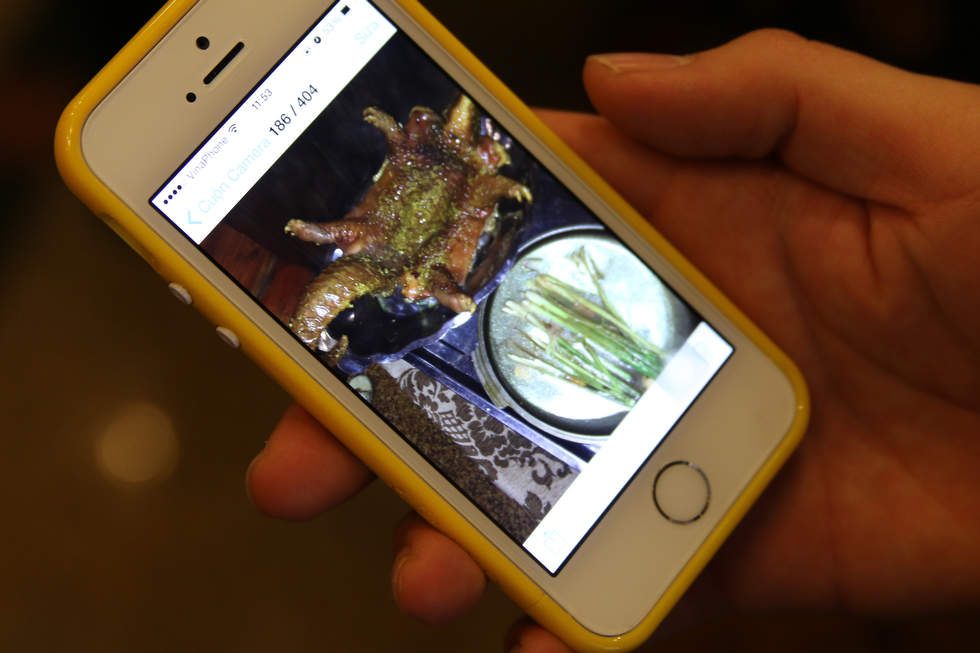
A waitress in Hanoi, Vietnam, shows how pangolin is prepared. Pangolin sells for as much as $350 per kilo: photo by John D. Sutter for CNN, 2014
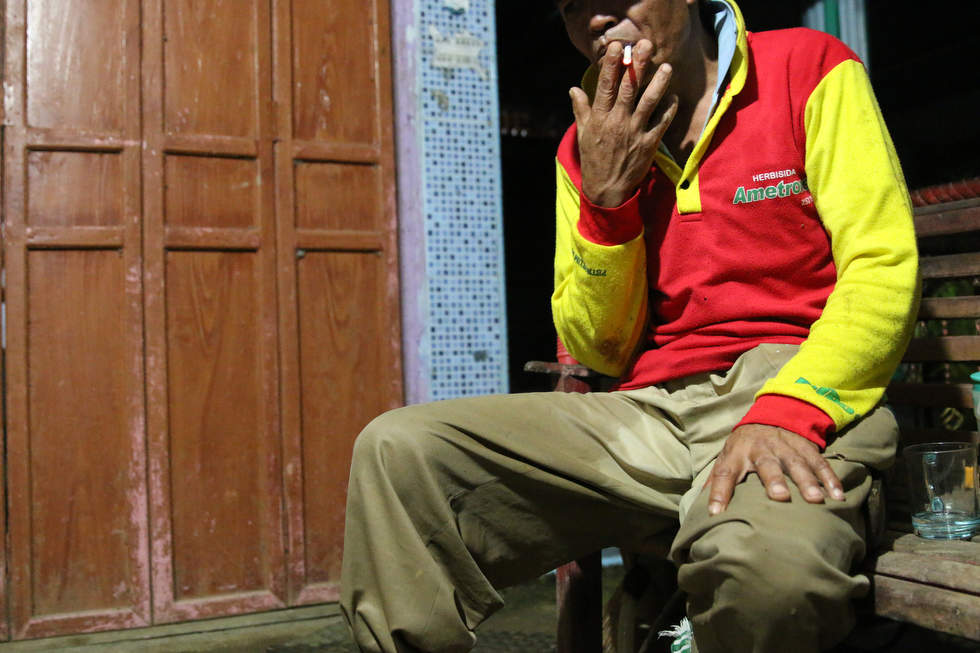
"You find pangolins, and I'll give you money." That's what Ruslan, 58, says he was told by a wildlife trader from out of town: photo by John D. Sutter for CNN, 2014
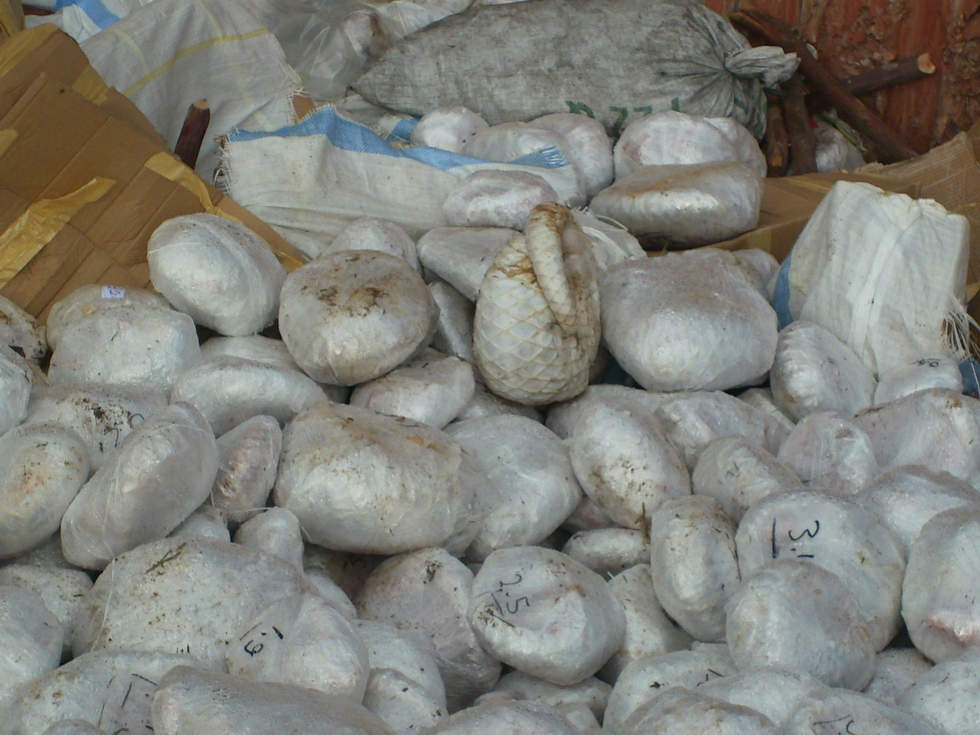
Pangolins are traded by the ton, frozen and alive. They're sometimes mixed with frozen fish or snakes as cover.: photo by John D. Sutter for CNN, 2014
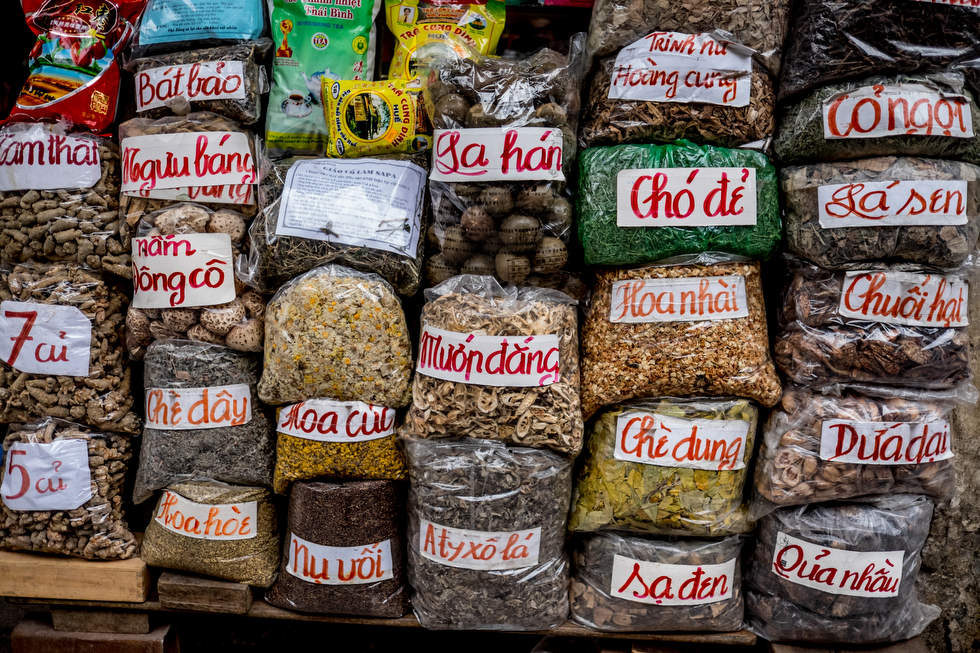
Traditional medicine has a long history in Vietnam and China. Pangolin scales are made of the same material as fingernails but are claimed to help with lactation issues and other ailments.: photo by John D. Sutter for CNN, 2014
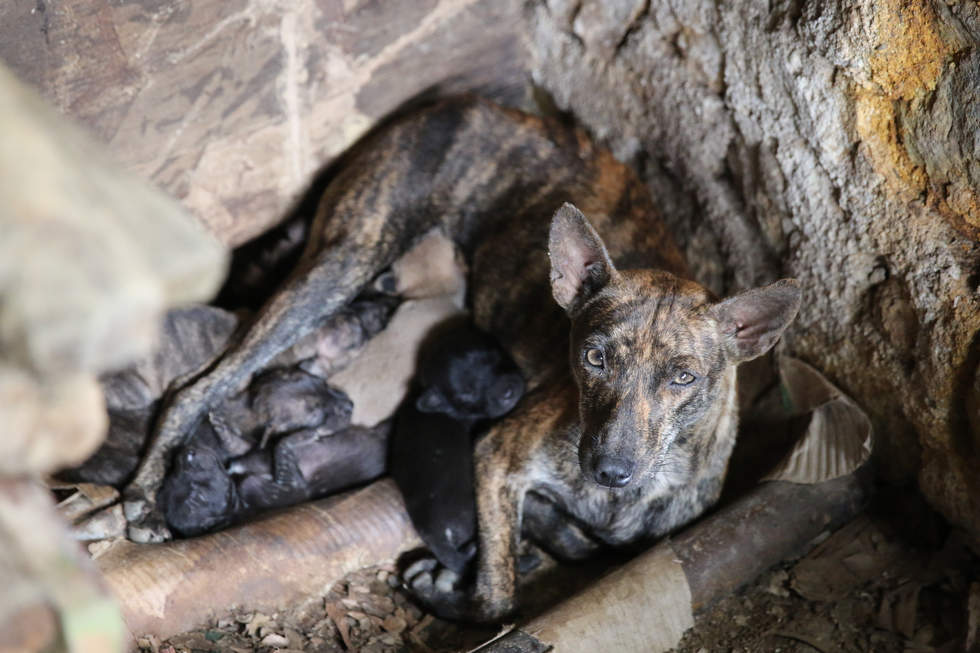
This hunting dog in Sumatra, Indonesia, has been trained on the scent of pangolins, which are difficult to find at night: photo by John D. Sutter for CNN, 2014
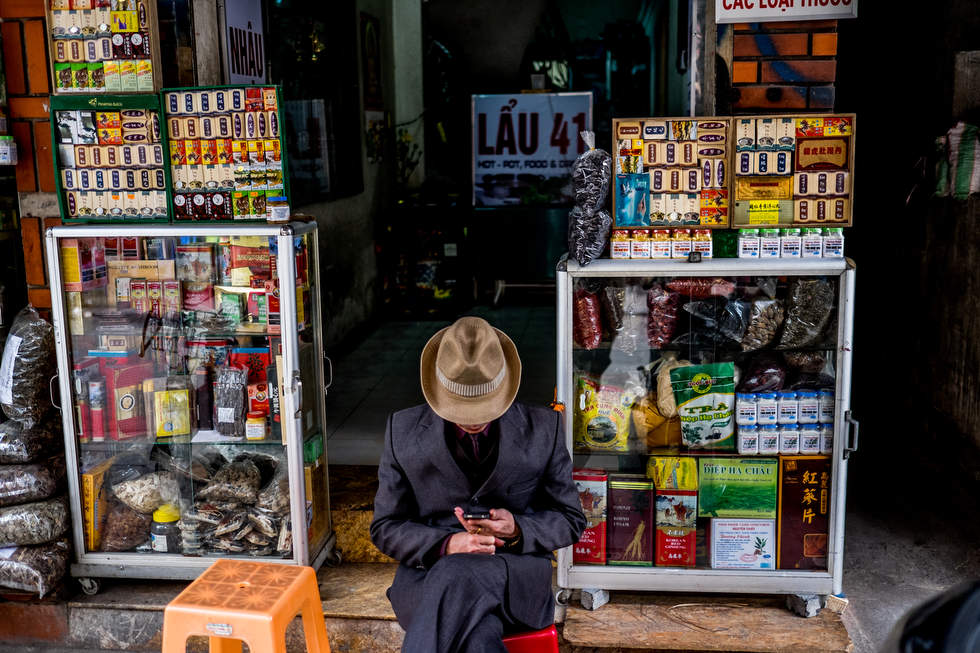
Pangolin scales are sold in traditional medicine shops like those found in an old quarter of Hanoi: photo by John D. Sutter for CNN, 2014
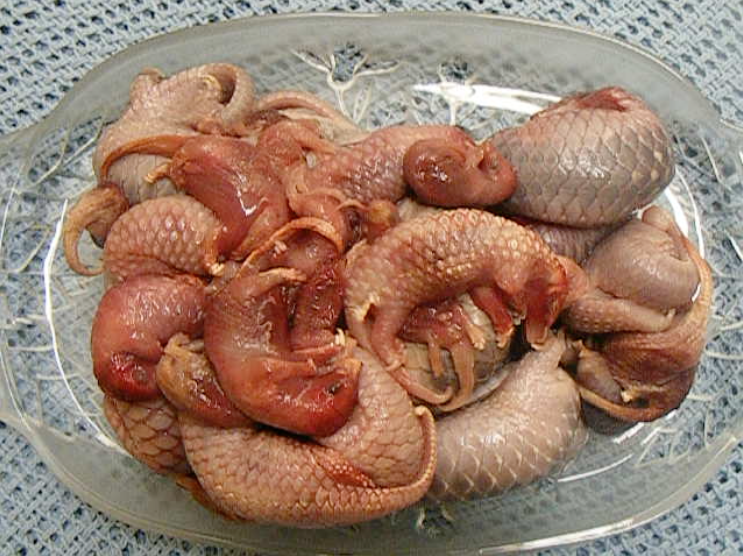
Pangolin fetus is an unproven aphrodisiac: photo by John D. Sutter for CNN, 2014
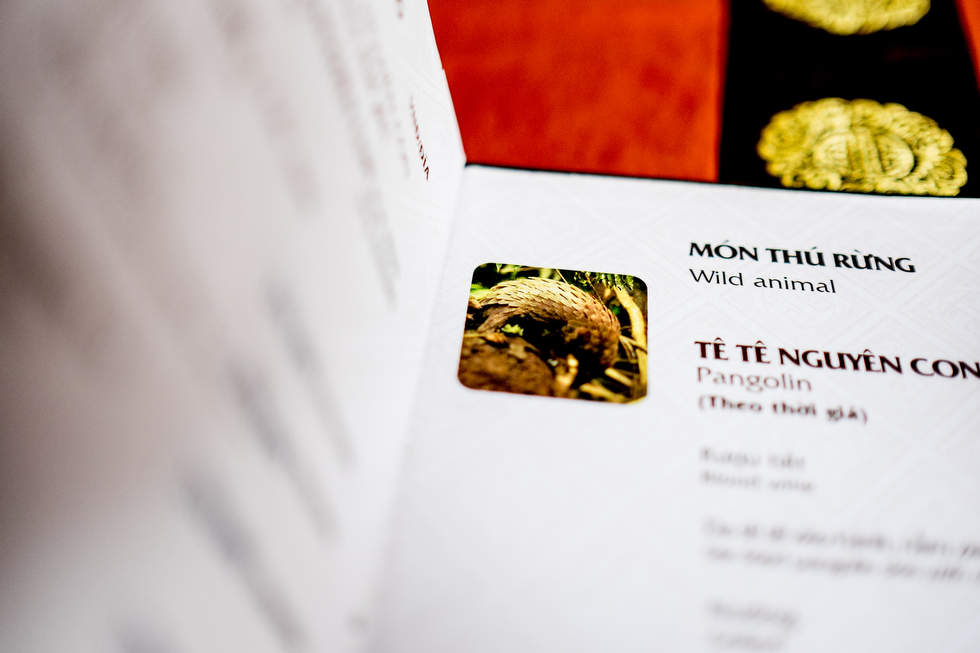
Pangolin is easy to find on menus in Hanoi. Some restaurants slit its throat in front of customers.: photo by John D. Sutter for CNN, 2014
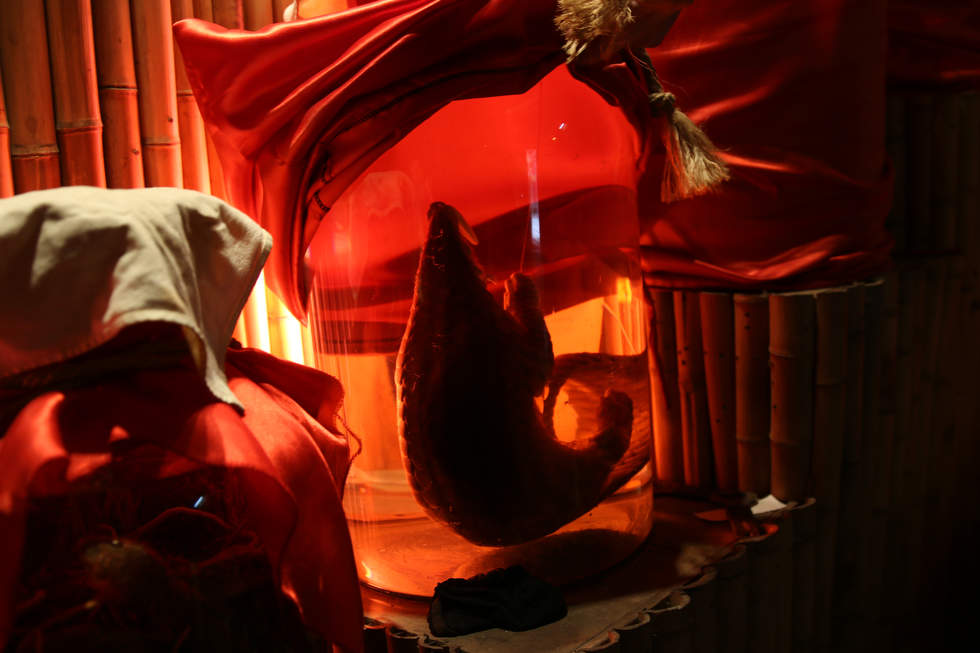
A restaurant in Hanoi kept this pangolin floating in rice wine. CNN reporter John Sutter was told it was removed after authorities were called: photo by John D. Sutter for CNN, 2014

Some pangolin hunters say they're just trying to support their families. They use the money to buy milk, not luxury items: photo by John D. Sutter for CNN, 2014
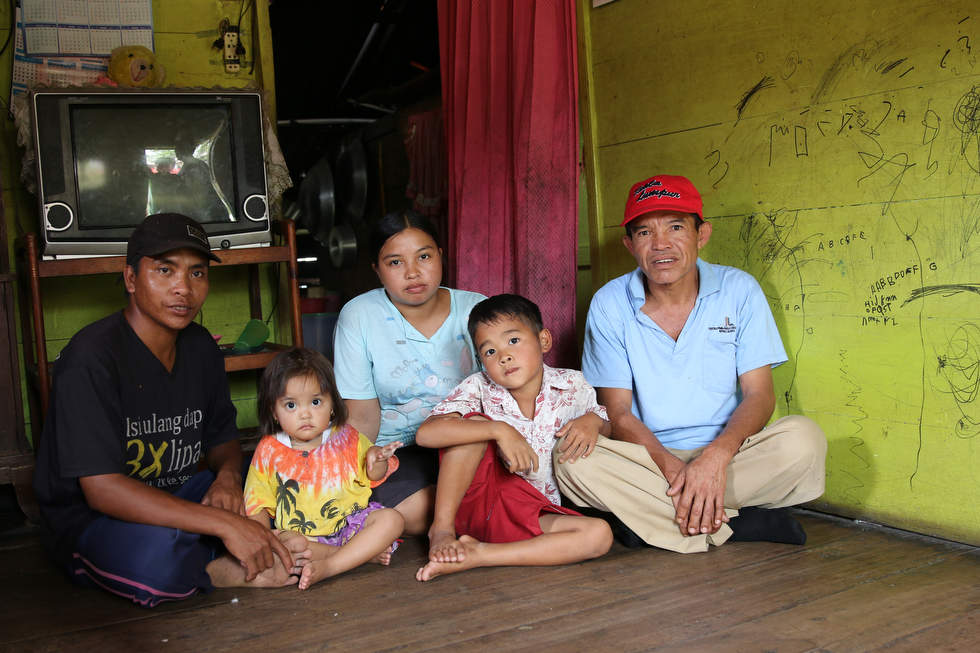
Ropi, a 29-year-old in Sumatra, Indonesia, said he has hunted pangolins to feed his kids; not to get rich: photo by John D. Sutter for CNN, 2014

Lucky is the biggest and friendliest pangolin at Cuc Phuong National Park in Vietnam. He weighed only 4 pounds when he was seized from the wildlife trade. He now weighs 17 pounds: photo by John D. Sutter for CNN, 2014

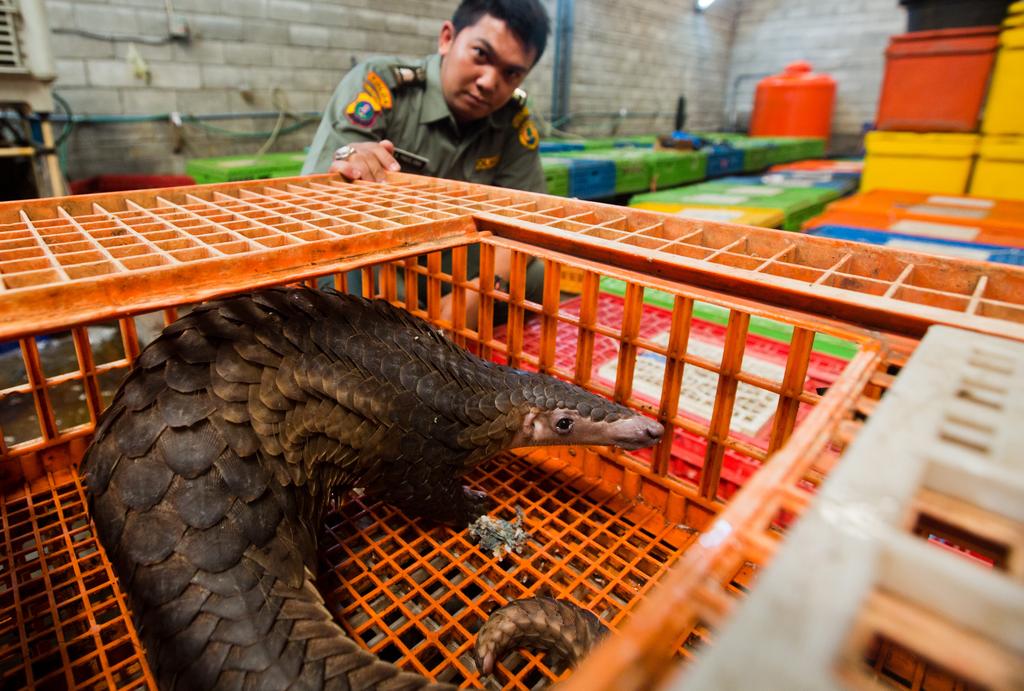





7 comments:
The pangolin, that animal "with a splendor
.............which man in all his vileness cannot
...........set aside" is no match for rapacious man in all his greedy glory--but then again, which creature is?
"To explain grace requires / a curious hand."
http://www.nytimes.com/2015/03/31/science/a-struggle-to-save-the-scaly-pangolin.html
From Sister Bernetta Quinn, O.S.F.: The Artist as Armored Animal:
__
Most of Marianne Moore's time at Bryn Mawr, according to an interview with Donald Hall, was spent in the biology laboratory; she tells him that she "found the biology courses -- minor, major, and histology -- exhilarating." She would have been well-acquainted with Linnaeus, who first classified the pangolin (1758) as Pholidota ("scaled animals"), its specific name derived from the Malayan word Guling, meaning a bolster or cylindrical cushion (sometimes the synonym roller is used, recalling the mammal's trick of escape). So important to her was this denizen of the African/Asian forests that the handsome 1936 collection of her verse arranged by H.D. and illustrated by Carlisle's George Plank not only took the animal as title but placed "The Pangolin" in the most prominent place, last. Renowned as [Moore] was for zoo-visiting, it is unlikely that she knew the pangolin any more directly than through books:
"The difficulty of feeding these animals in captivity makes them one of the greatest of rarities in zoological gardens.... So it is that everyone in the Western Hemisphere, to see them alive, must, like Mohammed, go to the less mobile object, in this case not the mountain, but the mantis."
So writes Robert T. Hatt in the article on pangolins which Miss Moore lists in her Notes, its reading a sign of her continued zest for biology.
*
...the ear, highly developed... as it is in the pangolin, who can hear a sound five miles away. Marianne Moore['s]... skill in balancing rhyme, assonance, other sound-structure elements creates what [Randall] Jarrell lauds as "a texture that will withstand any amount of rereading; a restraint and delicacy that make many more powerful poems seem obvious." "The Pangolin" begins with three words involving the broad a (ah), "Another armored animal,"' followed by Moore's favorite punctuation mark, the dash; the triple repetition results in music as well as emphasis.
*
Scientist Theodore H. Eaton depicts the pangolin as shy, looking for food only at night, the "night miniature artist engineer" of Marianne Moore -- a factor which may well have saved it from extermination, since its tasty flesh is highly prized by natives of the regions where it dwells. Moore's comment on its food (which she defines as ants, excluding cockroaches) corresponds with Hatt's remark that although the mammal is "not above picking up an occasional beetle or even a worm, such digressions are not an indication of an omnivorous diet." Actually the pangolin is the world's only creature living on ants, the others (misnamed anteaters) preferring the less ferocious termites.
Using who instead of which, Marianne Moore subtly builds up (among other ways) her subject into a kind of human hero "who endures/exhausting solitary trips through unfamiliar ground at night." These nocturnal efforts appear poetic as exquisitely expressed by stepping "'peculiarly that the outside/ edges of his hands [not paws] may bear the weight and save/ the claws/ for digging." The gait is pictured thus by Hatt: "As most others of its group, the giant pangolin walks on its knuckles and the sides of its feet. Thus the claws are kept sharp for digging."
With her penchant for economical metaphor and precision, Miss Moore likens the mantis to a snake, through a participle: "Serpentined." Herbert Lang's photograph accompanying the Hatt essay bears out her impression: it shows the odd creature wrapped around the trunk reptile-like as it descends to the ground... The concise metaphor recording how the creature winds himself around a tree-trunk if endangered, in non-violent opposition to an aggressor, is indicative of how this poet can make sheets out of nettles.
Police name a suspect in recent pangolin bust in Medan: Mei Leandha, Ekuatorial Environment News, 5 May 2015:
__
Medan, Ekuatorial – Police have arrested a suspect related to recent pangolin smuggling, said a senior investigator, in Medan, North Sumatra.
In April, Indonesian National Police’s Criminal Investigation Division (Bareskrim) confiscated at least five tons of slaughtered pangolins (Manis javanica) in Medan, North Sumatra. The bust also managed to save 96 pangolins which will be released back to the forest.
“We manage to declare SB as a suspect who admitted to be running this business for the past six months. Investigators are still collecting evidence. The suspect runs a very tight business, it is not going to be easy to reveal the network,” said deputy director of Specific Crime Unit at the Division Didit Wijanardi to reporters at the demolition of slaughtered pangolins, in Medan, North Sumatra, recently.
Wijanardi said that pangolin [is] usually sold to other Asian countries, including Malaysia, Thailand, Vietnam, and China for its scales and meat.
“The bust in Medan is worth of Rp 18.4 billion (US$ 1,4 million). A very huge business. This is the second largest bust, the first was in Palembang,” he said citing the 2008 major bust of at least 13 tons of dead pangolins earning the city a reputation as the hub for illegal wildlife trading.
The world overtaken is the newer nature; everything is drawn inexorably into the stream of commerce, no longer pangolin, but product.
You keep my eyes open, Tom, even though I want to close them. all the best to you, Donna
Dear TC: It is so depressing & infuriating to see these wondrous creatures turned into a menu "delicacy" or an ingredient in "traditional medicine." Soon all there will be are rats, roaches, and us.
Post a Comment